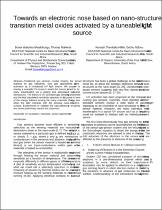 ResearchSpace
ResearchSpace
Towards an electronic nose based on nano-structured transition metal oxides activated by a tuneable UV light source
JavaScript is disabled for your browser. Some features of this site may not work without it.
- ResearchSpace
- →
- Research Publications/Outputs
- →
- Conference Publications
- →
- View Item
| dc.contributor.author |
Mwakikunga, Bonex W

|
|
| dc.contributor.author |
Malwela, T

|
|
| dc.contributor.author |
Hillie, T

|
|
| dc.contributor.author |
Ndlovu, G

|
|
| dc.date.accessioned | 2012-04-13T14:18:48Z | |
| dc.date.available | 2012-04-13T14:18:48Z | |
| dc.date.issued | 2011-10 | |
| dc.identifier.citation | Mwakikunga, B, Malwela, T, Hillie, T and Ndlovu, G. Towards an electronic nose based on nano-structured transition metal oxides activated by a tuneable UV light source. IEEE Sensor Conference, University of Limerick, Ireland, 27 October-1 November 2011, pp 1109-1112 | en_US |
| dc.identifier.issn | 978-1-4244-9288-6 | |
| dc.identifier.uri | http://ieeexplore.ieee.org/application/enterprise/entconfirmation.jsp?arnumber=6127403 | |
| dc.identifier.uri | http://hdl.handle.net/10204/5757 | |
| dc.description | Copyright: 2011 IEEE. This is the post-print version of the work. Reprinted, with permission, from Mwakikunga, B, Malwela, T, Hillie, T and Ndlovu, G. Towards an electronic nose based on nano-structured transition metal oxides activated by a tuneable UV light source. IEEE Sensor Conference, University of Limerick, Ireland, 27 October-1 November 2011, pp 1109-1112. This material is posted here with permission of the IEEE. Such permission of the IEEE does not in any way imply IEEE endorsement of any of CSIR Information Services' products or services. Internal or personal use of this material is permitted. However, permission to reprint/republish this material for advertising or promotional purposes or for creating new collective works for resale or redistribution must be obtained from the IEEE by writing to pubs-permissions@ieee.org. By choosing to view this document, you agree to all provisions of the copyright laws protecting it. | en_US |
| dc.description.abstract | Traditional gas sensors involve heating the sensor material for gas selectivity. New gas approaches require activation by a broadband UV light source. The authors propose to employ a tuneable UV source in which this source is tuned for its many wavelengths via a grating and associated optics and transducers. The theory of UV activated gas sensing is presented and the first calculated sensitivity spectrum is discussed in term of the energy balance among the many channels of energy loss when the light interacts with the sensing nano-structure’s surface. Experiments to validate the calculations are on-going and some preliminary results are presented. | en_US |
| dc.language.iso | en | en_US |
| dc.publisher | IEEE | en_US |
| dc.relation.ispartofseries | Workflow;7900 | |
| dc.subject | Gas sensors | en_US |
| dc.subject | UV light source | en_US |
| dc.subject | Alternative energy | en_US |
| dc.subject | UV activated gas | en_US |
| dc.subject | UV activation | en_US |
| dc.subject | Nanowires | en_US |
| dc.subject | Sensor spectrometer | en_US |
| dc.title | Towards an electronic nose based on nano-structured transition metal oxides activated by a tuneable UV light source | en_US |
| dc.type | Conference Presentation | en_US |
| dc.identifier.apacitation | Mwakikunga, B. W., Malwela, T., Hillie, T., & Ndlovu, G. (2011). Towards an electronic nose based on nano-structured transition metal oxides activated by a tuneable UV light source. IEEE. http://hdl.handle.net/10204/5757 | en_ZA |
| dc.identifier.chicagocitation | Mwakikunga, Bonex W, T Malwela, T Hillie, and G Ndlovu. "Towards an electronic nose based on nano-structured transition metal oxides activated by a tuneable UV light source." (2011): http://hdl.handle.net/10204/5757 | en_ZA |
| dc.identifier.vancouvercitation | Mwakikunga BW, Malwela T, Hillie T, Ndlovu G, Towards an electronic nose based on nano-structured transition metal oxides activated by a tuneable UV light source; IEEE; 2011. http://hdl.handle.net/10204/5757 . | en_ZA |
| dc.identifier.ris | TY - Conference Presentation AU - Mwakikunga, Bonex W AU - Malwela, T AU - Hillie, T AU - Ndlovu, G AB - Traditional gas sensors involve heating the sensor material for gas selectivity. New gas approaches require activation by a broadband UV light source. The authors propose to employ a tuneable UV source in which this source is tuned for its many wavelengths via a grating and associated optics and transducers. The theory of UV activated gas sensing is presented and the first calculated sensitivity spectrum is discussed in term of the energy balance among the many channels of energy loss when the light interacts with the sensing nano-structure’s surface. Experiments to validate the calculations are on-going and some preliminary results are presented. DA - 2011-10 DB - ResearchSpace DP - CSIR KW - Gas sensors KW - UV light source KW - Alternative energy KW - UV activated gas KW - UV activation KW - Nanowires KW - Sensor spectrometer LK - https://researchspace.csir.co.za PY - 2011 SM - 978-1-4244-9288-6 T1 - Towards an electronic nose based on nano-structured transition metal oxides activated by a tuneable UV light source TI - Towards an electronic nose based on nano-structured transition metal oxides activated by a tuneable UV light source UR - http://hdl.handle.net/10204/5757 ER - | en_ZA |





